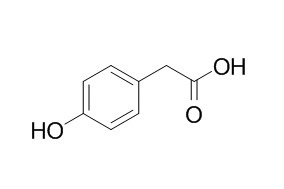4-Hydroxyphenylacetic acid
4-Hydroxyphenylacetic acid has anti-inflammatory activity,it attenuates inflammation and edema through suppressing hypertonic and hypoxic induction of HIF-1α in seawater aspiration-induced lung injury in rats. 4-Hydroxyphenylacetic acid is active against the root-lesion nematode, Pratylenchus penetrans, and the pine wood nematode.
Inquire / Order:
manager@chemfaces.com
Technical Inquiries:
service@chemfaces.com
Tel:
+86-27-84237783
Fax:
+86-27-84254680
Address:
1 Building, No. 83, CheCheng Rd., Wuhan Economic and Technological Development Zone, Wuhan, Hubei 430056, PRC
Providing storage is as stated on the product vial and the vial is kept tightly sealed, the product can be stored for up to
24 months(2-8C).
Wherever possible, you should prepare and use solutions on the same day. However, if you need to make up stock solutions in advance, we recommend that you store the solution as aliquots in tightly sealed vials at -20C. Generally, these will be useable for up to two weeks. Before use, and prior to opening the vial we recommend that you allow your product to equilibrate to room temperature for at least 1 hour.
Need more advice on solubility, usage and handling? Please email to: service@chemfaces.com
The packaging of the product may have turned upside down during transportation, resulting in the natural compounds adhering to the neck or cap of the vial. take the vial out of its packaging and gently shake to let the compounds fall to the bottom of the vial. for liquid products, centrifuge at 200-500 RPM to gather the liquid at the bottom of the vial. try to avoid loss or contamination during handling.
J Chromatogr B Analyt Technol Biomed Life Sci.2022, 1203:123307.
BMC Pharmacol Toxicol.2018, 19(1):5
Molecules.2015, 20(10):19172-88
Molecules.2021, 26(16):4722.
Neurotoxicology.2022, 91:218-227.
Hanoi University of Pharmacy2023, 14(1):30-39.
Eur J Pharmacol.2024, 975:176644.
Oxid Med Cell Longev.2021, 2021:4883398.
Mutlu Yanic S, Ates EG. JOTCSA.2023, 10(4);893-902.
J.Soc.Cosmet.Sci.Korea2024, 50(3): 261-270
Related and Featured Products
Int J Mol Sci. 2014 Jul 21;15(7):12861-84.
4-hydroxyphenylacetic acid attenuated inflammation and edema via suppressing HIF-1α in seawater aspiration-induced lung injury in rats.[Pubmed:
25050781]
4-Hydroxyphenylacetic acid (4-HPA) is an active component of Chinese herb Aster tataricus which had been widely used in China for the treatment of pulmonary diseases.
METHODS AND RESULTS:
The aim of this study is to investigate the effect of 4-Hydroxyphenylacetic acid on seawater aspiration-induced lung injury. Hypoxia-inducible factor-1α (HIF-1α) siRNA and permeability assay were used to study the effect of 4-Hydroxyphenylacetic acid on the production of inflammatory cytokines and monolayer permeability in vitro. The results showed that 4-Hydroxyphenylacetic acid reduced seawater instillation-induced mortality in rats. In lung tissues, 4-Hydroxyphenylacetic acid attenuated hypoxia, inflammation, vascular leak, and edema, and decreased HIF-1α protein level. In primary rat alveolar epithelial cells (AEC), 4-Hydroxyphenylacetic acid decreased hypertonicity- and hypoxia-induced HIF-1α protein levels through inhibiting the activations of protein translational regulators and via promoting HIF-1α protein degradation. In addition, 4-Hydroxyphenylacetic acid lowered inflammatory cytokines levels through suppressing hypertonicity- and hypoxia-induced HIF-1α in NR8383 macrophages. Moreover, 4-Hydroxyphenylacetic acid decreased monolayer permeability through suppressing hypertonicity and hypoxia-induced HIF-1α, which was mediated by inhibiting vascular endothelial growth factor (VEGF) in rat lung microvascular endothelial cell line (RLMVEC).
CONCLUSIONS:
In conclusion, 4-Hydroxyphenylacetic acid attenuated inflammation and edema through suppressing hypertonic and hypoxic induction of HIF-1α in seawater aspiration-induced lung injury in rats.
Z Naturforsch C. 2011 Jan-Feb;66(1-2):31-4.
Nematicidal activities of 4-hydroxyphenylacetic acid and oidiolactone D produced by the fungus Oidiodendron sp.[Pubmed:
21476434]
METHODS AND RESULTS:
Two nematicides, 4-Hydroxyphenylacetic acid (4-HPA) (1) and oidiolactone D (2), were isolated from cultures of the fungus Oidiodendron sp., and their structures were identified by spectroscopic analyses. Compound 2 showed nematicidal activities against the root-lesion nematode, Pratylenchus penetrans, and the pine wood nematode, Bursaphelenchus xylophilus.
CONCLUSIONS:
4-Hydroxyphenylacetic acid was also active against these two nematodes but to a lesser extent.



